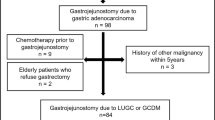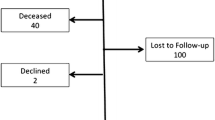Abstract
In order to investigate whether the previously found excess mortality in surgically-treated patients with peptic ulcer might be due partly to the resections employed, a survival analysis was undertaken in 824 patients 8–13 years after different types of vagotomy. These patients had been submitted to selective gastric vagotomy with drainage, selective gastric vagotomy with antrectomy or parietal cell vagotomy with or without drainage for duodenal ulcer, pyloric ulcer, prepyloric ulcer, or combined ulceration during the period from 1972 to 1977.
A statistically significant excessive mortality was found for both sexes in the total material compared to the background population. Analysis of the material, subdivided according to the operative methods employed, revealed a significant excess mortality in men treated with selective gastric vagotomy and antrectomy, whereas the mortality rates were slightly and insignificantly raised in the nonantrectomy groups. No significant difference in the mortality could be demonstrated in relation to the site of the ulcers.
Analysis of the cause-specific mortality revealed a significantly raised mortality from gastrointestinal diseases, including a significant excessive mortality in the subgroups of benign peptic ulcer and cirrhosis of the liver. Likewise, the death rate from accidents including the subgroup of suicide was significantly increased. The overall mortality from malignancies was insignificantly raised among patients, whereas cancer in the stomach was significantly increased. An increased mortality from cancer in the lungs and pancreas did not reach statistical significance. These findings are in reasonable accordance with other studies. A significantly increased mortality from gastric cancer has been usual, although not a constant finding after gastric resection. This study has shown, as the first substantial series, that gastric cancer rate is increased after vagotomy as well.
Résumé
Pour savoir si la mortalité accrue chez les patients ayant subi un traitement chirurgical de leur maladie ulcéreuse ne pouvait être due aux types de résections chirurgicales employées, une analyse de la survie a été effectuée chez 824 patients 8 à 13 ans après divers types de vagotomie. Ces patients avaient subi soit une vagotomie sélective associée à un geste de drainage interne ou à une antrectomie, soit une vagotomie ultrasélective suivie ou pas d'un geste de drainage interne entre 1972 et 1977. Les indications étaient soit un ulcère soit duodénal, soit pylorique, soit prépylorique, soit une combinaison de ces types d'ulcères.
Une différence statistiquement significative a été trouvée dans la mortalité chez les deux sexes pour l'ensemble des patients comparé à la population générale. L'analyse plus fine, selon le type d'intervention, a montré qu'il y avait une augmentation significative dans la mortalité chez le patient traité par vagotomie sélective avec antrectomie. La mortalité était plus importante (mais pas de manière significative) dans les groupes san antrectomie. Il n'y avait pas de différence de mortalité selon le site des ulcères.
L'analyse des causes de mortalité a montré une augmentation de celle-ci due à des maladies gastrointestinales comme la maladie ulcéreuse bénigne et la cirrhose alcoolique du foie. De même, la mortalité due au suicide était significativement augmentée. La mortalité globale due à des maladies malignes était augmentée (significativement seulement pour le cancer gastrique). L'augmentation de mortalité due au cancer bronchopulmonaire n'a pas été statistiquement significative. Ces données s'accordent avec celles des autres études. Une augmentation de la mortalité due au cancer gastrique est habituelle mais non constante après résection gastrique. Cette étude, comme la précédente, montre que la fréquence de cancer gastrique augmente également après vagotomie.
Resumen
Con el objeto de investigar si la mortalidad, previamente considerada excesiva, en pacientes con tratamiento quirúrgico para úlcera péptica podría ser en parte debida a las resecciones empleadas, se realizó un análisis de supervivencia en 824 pacientes, 8–13 años después de haber sido sometidos a diferentes tipos de vagotomía. Los pacientes habían sido sometidos a vagotomía selectiva con drenaje, vagotomía selectiva con antrectomía o vagotomía de células parietales con o sin drenaje, como tratamiento de úlcera duodenal, úlcera pilórica, úlcera prepilórica, o ulceración combinada en el período 1972–1977.
Se encontró una mortalidad estadísticamente significativa en ambos sexos en el total del material estudiado en comparación con un grupo control de población. El análisis del material, subdividido de acuerdo a los métodos operatorios empleados, reveló un exceso significativo de mortalidad en los hombres tratados con vagotomía selectiva y antrectomía, en tanto que las tasas de mortalidad resultaron leve e insignificativamente aumentadas en los grupos no sometidos a antrectomía. No se demostró diferencia en la mortalidad en relación con la ubicación de las úlceras.
El análisis de las causas específicas de mortalidad reveló un aumento significativo de la mortalidad para enfermedades gastrointestinales incluso una mortalidad estadísticamente excesiva en los subgrupos con úlcera péptica benigna y cirrosis hepática. Así mismo, la tasa de mortalidad por accidentes, incluyendo el subgrupo de suicidio, apareció significativamente aumentado. La mortalidad global por neoplasia maligna resultó insignificativamente incrementada en el grupo de pacientes, mientras el cáncer de estómago apareció significativamente aumentado. Una mayor mortalidad por cáncer pulmonar y pancreático no alcanzó significación estadística. Estos hallazgos se encuentran en concordancia razonable con otros estudios. La mortalidad por cáncer gástrico significativamente aumentada ha sido un hallazgo usual, aunque no constante, después de resección gástrica. Este estudio muestra por primera vez en una serie numerosa, que la tasa de cáncer gástrico también está aumentada después de vagotomiá.
Similar content being viewed by others
References
Krause, U.: Late prognosis after partial gastrectomy for ulcer. Acta Chir. Scand.114:341, 1958
Westlund, K.: Mortality of peptic ulcer patients. Acta Med. Scand.174[Suppl. 402], 1963
Hirohata, T.: Mortality from gastric cancer and other causes after medical or surgical treatment for gastric ulcer. J. Natl. Cancer. Inst.41:895, 1968
Lindskov, J., Nielsen, J., Amdrup, E., Christiansen, P., Fenger, C., Jensen, H.-E., Damgaard Nielsen, S.A.: Causes of death in patients with gastric ulcer. Acta Chir. Scand.141:670, 1975
Viskum, K.: Ulcer Disease. A Comparison of Some Clinical and Genetic Aspects in Patients Suffering from Duodenal Ulcer, Gastric Ulcer and the Pseudo-Ulcer Syndrome, Copenhagen, Laegeforeningens Forlag, 1977
Bonnevie, O.: Epidemiologiske Studier af Gastroduodenale Ulcera's Incidens, Kombination og Forløb, Copenhagen, Eget Forlag, 1979
Ross, A.H.M., Smith, M.A., Anderson, J.R., Small, W.P.: Late mortality after surgery for peptic ulcer. N. Engl. J. Med.307:519, 1982
Eriksson, S.B.S.: The operated stomach. Bulletin no. 36, Department of Surgery, University of Lund, 1983
Fischer, A.B.: The Long-Term Results following Billroth II Resection for Duodenal Ulcer, Copenhagen, Laegeforeningens Forlag, 1986
Amdrup, E., Andersen, D., Høstrup, H.: The Aarhus County Vagotomy Trial. I. An interim report on primary results and incidence of sequelae following parietal cell vagotomy and selective gastric vagotomy in 748 patients. World J. Surg.2:85, 1978
Andersen, D., Høstrup, H., Amdrup, E.: The Aarhus County Vagotomy Trial. II. An interim report on reduction in acid secretion and ulcer recurrence rate following parietal cell vagotomy and selective gastric vagotomy. World J. Surg.2:91, 1978
Helsingen, N., Hillestad, L.: Cancer development in the gastric stump after partial gastrectomy for ulcer. Ann. Surg.143:173, 1956
Domellöf, L., Eriksson, S., Janunger, K.-G.: Late occurrence of precancerous changes and carcinoma of the gastric stump after Billroth II resection. Acta Chir. Scand.141:292, 1975
Liavaag, K.: Cancer development in gastric stump after partial gastrectomy for peptic ulcer. Ann. Surg.155:103, 1962
Shafer, R.B., Ripley, D., Swaim, W., Mahmud, K., Doscherholmen, A.: Hematologic alterations following partial gastrectomy. Am. J. Med. Sci.266:240, 1973
Author information
Authors and Affiliations
Additional information
Aarhus County Vagotomy Trial: Erik Amdrup, M.D., Ph.D., Daniel Andersen, M.D., Ph.D., Finn Hanberg Sørensen, M.D., Ph.D., and Hans Høstrup, M.D., Ph.D.
Aided by a grant from the Danish Medical Research Council (SLF 12-5848).
Rights and permissions
About this article
Cite this article
Ditlevsen, S. Survival after vagotomy: Results of the Aarhus county vagotomy trial. World J. Surg. 13, 776–780 (1989). https://doi.org/10.1007/BF01658433
Issue Date:
DOI: https://doi.org/10.1007/BF01658433




